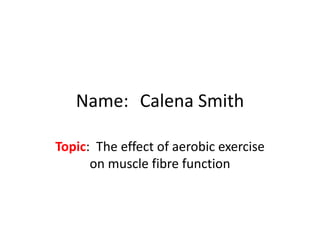
Exercise phy pwerpnt
- 1. Name: Calena Smith Topic: The effect of aerobic exercise on muscle fibre function
- 2. Key Words Aerobic Exercise Muscle Muscle fibre A.T.Pase Mitochondria Myoglobin Slow twitch Fast Twitch
- 3. Definition of terms • Aerobic Exercise: is physical exercise that intends to improve the oxygen system. • Aerobic means "with oxygen", and refers to the use of oxygen in the body's metabolic or energy-generating process. Many types of exercise are aerobic, and by definition are performed at moderate levels of intensity for extended periods of time.
- 4. Muscle • an organ that, by cellular contraction, produces the movements of life
- 5. Muscle fibre • any of the cells of skeletal or cardiac muscle tissue which is an elongated contractile cell that forms the muscles of the body • are mainly composed of the proteins, actin and myosin.
- 6. A.T.Pase • Enzymes that cause the conversion of A.D.P to release energy
- 7. Mitochondria • are known as the powerhouses of the cell. They are organelles that act like a digestive system that takes in nutrients, breaks them down, and creates energy for the cell.
- 8. Myoglobin • is a protein and has oxygen bound to it, thus providing an extra reserve of oxygen so that the muscle can maintain a high level of activity for a longer period of time.
- 9. Slow Twitch • Muscle fibers that produce energy by converting fats into energy aerobically.
- 10. Fast Twitch • Muscle fibers that produce energy by breaking down glycogen in the absence of oxygen. They produce rapid contractions, but create lactic acid as a by-product.
- 12. Types of Muscle Fibre there are two main type of muscle fibre: • Type I – often called slow-twitch or slow fibre or highly-oxidative muscle fibres • Type II – often called fast-twitch or Fast fibers or low-oxidative muscle fibres
- 13. Slow Twitch Muscle Fibre • contain more mitochondria • smaller in size • have better blood supply • contract more slowly
- 14. more fatigue resistant than their fast-twitch brothers. produce energy, primarily, through aerobic metabolism of fats and carbohydrates.
- 15. Type 1 Muscle Fibre are only aerobic and contain an abundance of mitochondria (where the Krebs cycle occurs). The major source of energy for Type I is fat through the Krebs cycle.
- 16. They also contain large amounts of myoglobin: a pigment similar to haemoglobin that also stores oxygen – that provides an additional store of oxygen for when oxygen supply is limited
- 17. Type II has three subgroups: Fast Oxidative Glycolytic Fast Glycolytic Indeterminate
- 18. Fast Oxidative Glycolytic - Aerobic burns glucose mitochondria present but not as many as type I
- 19. Fast Glycolytic • Anaerobic • burns glucose • no mitochondria
- 20. produces lots of lactic acid which can enter mitochondria of type I or IIa heart muscle can utilize all the lactic acid it can get. Any lactic acid left over enters the liver and is reconstitued into glucose.
- 21. Indeterminate undifferentiated fibers -can become type IIa or IIb
- 22. The effect of aerobic exercise on muscle fibre Increase blood capillaries to muscle fibre Increase in number and size of mitrochrondria Increase enzymic action (A.T.Pase)
- 23. Exercise suitable for slow twitch muscle fibre • Marathon • Cross country cycling • Swimming • Skating • Skiing • Triathlon, Decathlon, Heptathlon • Running